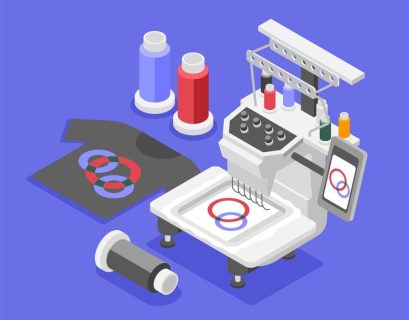When creating detailed designs, especially for apparel, hats, or other textile items, custom embroidery digitizing services offer an essential way to achieve precision and visual impact. Embroidery digitizing is the process of converting artwork into a digital file readable by embroidery machines. This transformation enables even complex designs to be embroidered with clarity and detail. For businesses, organizations, or individuals looking to create high-quality embroidered items, leveraging custom embroidery digitizing services effectively can make a substantial difference in the final product. Here are essential tips to consider to get the most out of custom embroidery digitizing services and ensure your detailed designs come to life beautifully.
To start, understanding the design itself is critical. Before sending a design to a custom embroidery digitizing service, take time to evaluate the elements that are most essential. Fine details, small text, intricate patterns, and color gradients all play a role in the design’s complexity. With embroidery digitizing, certain features may need to be adjusted for better clarity in the final embroidered product. For example, very fine lines may need to be thickened, and some elements may need to be simplified without losing the design’s essence. Working closely with an experienced digitizer or custom embroidery digitizing service can help in determining which parts of the design may require such adjustments. A professional service will suggest design modifications that maintain the aesthetic while adapting the design for optimal embroidery.
Choosing the right stitch type is also fundamental in creating detailed embroidery designs. There are multiple stitch types available—satin, fill, and running stitches are among the most common. Satin stitches are often used for outlines or narrow sections, providing a smooth, slightly raised appearance. Fill stitches cover larger areas, giving solidity and texture, while running stitches work well for fine details and outlines without adding too much bulk. Custom embroidery digitizing services utilize these stitch types in various combinations to achieve a design that balances clarity and texture. Knowing which stitch type works best for each part of your design helps in creating a detailed and high-quality embroidery outcome.
Furthermore, selecting appropriate thread colors and types is critical for bringing out the vibrancy and contrast in a design. Custom embroidery digitizing services usually offer a wide variety of thread colors and materials, from cotton to polyester and specialty threads like metallic or neon. Carefully consider how the colors in your design will translate to thread colors, as some colors that look vivid on a screen may not appear the same in thread form. To assist with color selection, professional custom embroidery digitizing services often provide color charts, which are essential to review before finalizing a design. Matching the thread colors as closely as possible to the original artwork enhances the design’s integrity and ensures it looks cohesive once embroidered.
Design size and placement are equally important in detailed embroidery. A design that looks clear on a screen might lose its detail when downsized for embroidery on smaller items, such as a cap or the front of a shirt. Custom embroidery digitizing services understand the nuances of resizing designs for various garment placements and offer resizing advice accordingly. It’s crucial to think about the item the design will be embroidered on—larger designs are typically suited for the back of a jacket, while smaller, simpler designs work better on shirt collars or cuffs. When you partner with a custom embroidery digitizing service, discussing the intended embroidery placement helps to tailor the design to that specific item, ensuring the final product looks sharp and is well-proportioned.
One aspect often overlooked in embroidery digitizing is the fabric type. Each fabric has unique characteristics that can impact the final embroidered result. A thick, sturdy material, like denim, will support more detailed stitching without puckering, while softer, stretchable fabrics like cotton or polyester blends might require additional backing or adjustments to the stitch density to prevent distortion. Professional custom embroidery digitizing services take fabric type into account during the digitizing process, optimizing the stitch density and tension settings to suit the material. This attention to fabric detail ensures the design will hold up well under repeated washing and wearing, maintaining both its color and shape.
Using high-quality digitizing software is another essential factor. Reputable custom embroidery digitizing services utilize advanced digitizing software, which enables greater control over stitch density, direction, and layering. Such software provides tools for scaling designs without losing detail and helps in adjusting stitch types to optimize the look and feel of each design element. This software also enables accurate simulation of the embroidery process, giving both the client and the digitizer a preview of how the final product will appear. Custom embroidery digitizing services that invest in top-tier software deliver a more precise and polished outcome, so look for a service provider that highlights its use of high-quality digitizing software as a standard practice.
Don’t underestimate the importance of testing the design. Once the digital file is complete, most custom embroidery digitizing services will run a sample test on fabric to check the accuracy and quality of the digitized design. This trial run allows the service to detect any issues with stitch density, color matching, or thread tension before the final production begins. By reviewing a test sample, you can evaluate how well the design translates from the digital file to the actual embroidered item and make any final adjustments. Testing is especially valuable for intricate designs, where even minor errors can impact the overall appearance.
Communication with the custom embroidery digitizing service is essential throughout this process. Many designs require adjustments, even if the initial artwork is high quality, and conveying your expectations clearly will help the digitizing service deliver a satisfactory result. Be sure to communicate any specific requirements you have, such as the preferred level of detail, exact color matching, or particular stitch types. A good custom embroidery digitizing service will welcome feedback and provide recommendations that help achieve the best possible outcome.
After the embroidery process is complete, consider the maintenance of the embroidered items. Custom embroidery digitizing services often provide guidelines for washing, drying, and ironing to prolong the life of the embroidery. Thread colors may fade or bleed if washed incorrectly, and improper care can affect the stitch integrity. Adhering to these guidelines ensures that the embroidered items retain their quality over time and look as vibrant and detailed as when first created.
When it comes to creating detailed designs with custom embroidery digitizing services, patience and planning are key. Taking the time to evaluate each design, understand the available stitch types, select suitable colors, and consider fabric type all contribute to a better final product. Custom embroidery digitizing is a specialized process that, when done well, can turn any design into a visually stunning embroidered piece. By partnering with a skilled custom embroidery digitizing service, you gain access to the expertise needed to navigate the complexities of embroidery, ensuring that your designs stand out for their clarity, color, and craftsmanship.
Conclusion
Custom embroidery digitizing services play a pivotal role in transforming detailed designs into high-quality embroidered items. By focusing on aspects like stitch type, thread color, design size, fabric compatibility, and testing, you can enhance the precision and appearance of any embroidered piece. Effective communication with the custom embroidery digitizing service also enables a better alignment between your vision and the final product, resulting in embroidery that is both aesthetically pleasing and durable. Leveraging the knowledge and technology that professional custom embroidery digitizing services offer ensures that your designs, no matter how intricate, are represented faithfully and beautifully through the art of embroidery.









